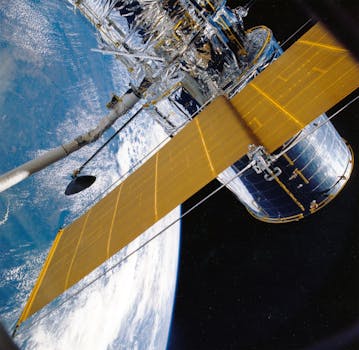
The Future of Satellites: Revolutionizing Global Communication and Exploration
The future of satellites is rapidly evolving, with advancements in technology and innovation poised to revolutionize global communication, exploration, and beyond. The focus keyword, Future of Satellites, is an exciting and dynamic field that holds tremendous potential for growth and development. As we look to the future, it’s clear that satellites will play an increasingly important role in shaping our world and connecting us like never before.
Section 1: Introduction to the Future of Satellites
Satellites have been a cornerstone of modern technology for decades, providing critical services such as navigation, communication, and weather forecasting. However, the next generation of satellites is set to take this technology to new heights, with advancements in areas such as satellite internet, Earth observation, and space exploration. The future of satellites is not just about incremental improvements, but rather a transformative shift in how we use and interact with space-based technologies.
One of the key drivers of this transformation is the development of satellite constellations, which involve launching hundreds or even thousands of small satellites into low-Earth orbit. These constellations have the potential to provide global coverage, enabling services such as satellite internet, IoT connectivity, and real-time Earth observation. Companies such as SpaceX, Amazon, and OneWeb are at the forefront of this trend, with ambitious plans to launch massive constellations in the coming years.
Section 2: Advancements in Satellite Technology
Advances in satellite technology are also playing a critical role in shaping the future of satellites. One of the most significant developments is the use of phased array antennas, which allow satellites to steer and shape their beams with greater precision. This technology enables satellites to provide higher throughput, greater flexibility, and improved interference mitigation. Additionally, the development of new propulsion systems, such as electric propulsion and advanced ion engines, is enabling satellites to operate more efficiently and extend their lifespan.
Another area of innovation is the use of artificial intelligence and machine learning in satellite operations. AI-powered systems can analyze vast amounts of data from satellites, enabling real-time decision-making and predictive maintenance. This can help to improve the reliability and performance of satellites, while also reducing the risk of anomalies and failures. Furthermore, AI can be used to optimize satellite orbits, ensuring that they are operating in the most efficient and effective manner possible.
Section 3: Applications and Implications of the Future of Satellites
The future of satellites has far-reaching implications for a wide range of industries and applications. One of the most significant areas of impact is in the field of global communication, where satellites will play a critical role in providing connectivity to remote and underserved communities. Satellite internet has the potential to bridge the digital divide, enabling access to education, healthcare, and economic opportunities for millions of people around the world.
In addition to communication, satellites will also have a major impact on areas such as Earth observation, navigation, and space exploration. The use of satellite-based Earth observation systems can provide critical insights into the health of our planet, enabling us to monitor climate change, track natural disasters, and manage natural resources more effectively. Similarly, advances in satellite navigation will enable more precise and reliable positioning, which is critical for applications such as aviation, maritime, and autonomous vehicles.
Section 4: Challenges and Opportunities
While the future of satellites holds tremendous promise, there are also significant challenges that must be addressed. One of the most pressing concerns is the issue of space debris, which poses a major risk to the long-term sustainability of space-based technologies. As the number of satellites in orbit increases, the risk of collisions and debris generation also grows, highlighting the need for more effective debris mitigation and removal strategies.
Another challenge is the need for greater international cooperation and regulation, as the use of satellites raises complex questions about sovereignty, jurisdiction, and liability. The development of clear and consistent regulatory frameworks will be essential to ensuring that the benefits of satellite technology are realized, while minimizing the risks and negative consequences.
In conclusion, the future of satellites is a rapidly evolving and dynamic field, with tremendous potential for growth and innovation. As we look to the future, it’s clear that satellites will play an increasingly important role in shaping our world and connecting us like never before.




